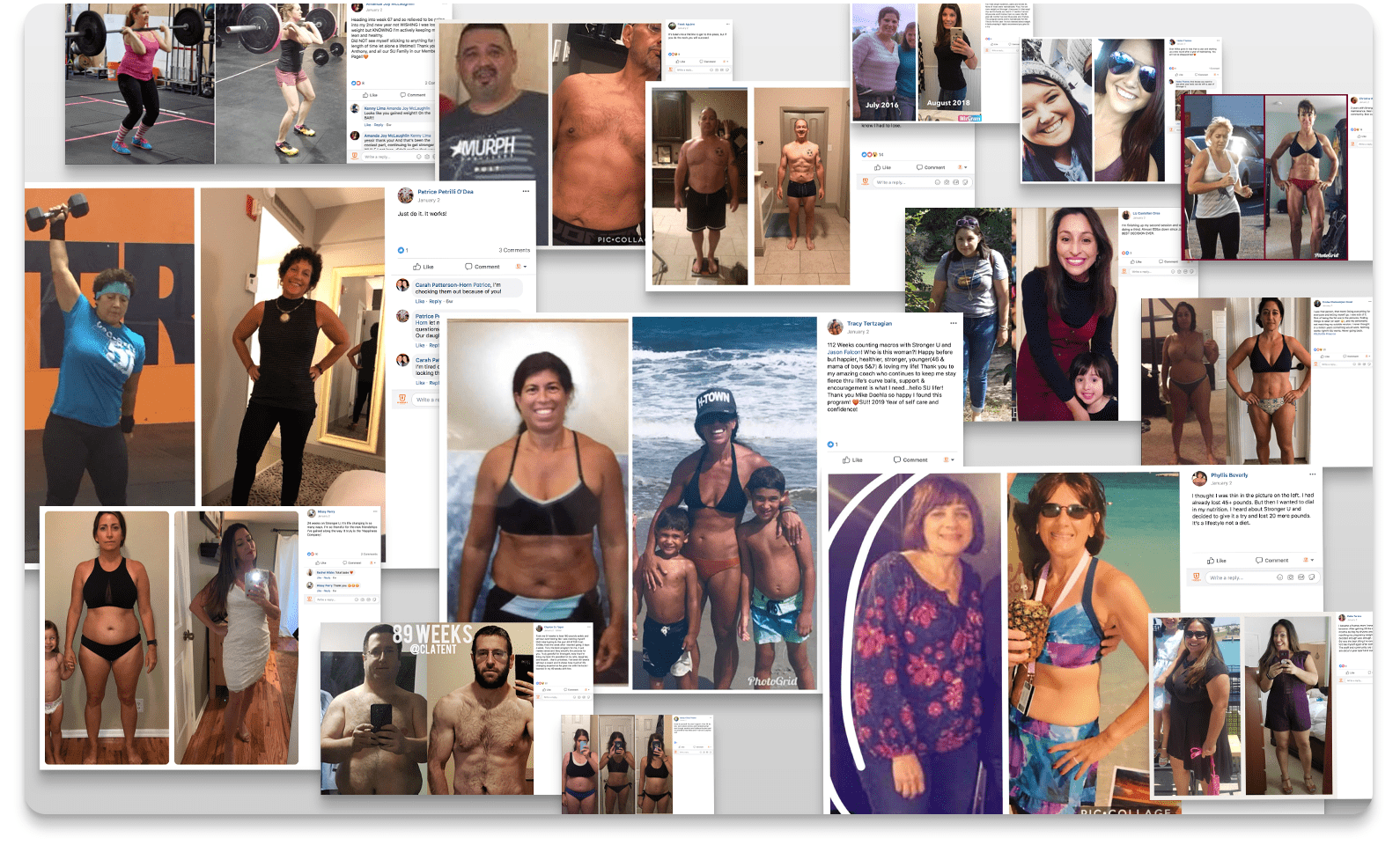From lack of know-how to fear of failure, there are plenty of reasons coaches struggle to develop an engaged social media following. But it may not be as complicated as it seems. Try this simple but effective advice from Precision Nutrition experts who have used social media to build thriving businesses.
- Want to listen instead of read? Download the audio recording here…
++++
Frustrating. Useless. Scary. Humbling.
Those are just a few of the ways we hear coaches describe their experience using social media for their business.
Perhaps you can relate.
It could be you’ve tried Facebook or Instagram or YouTube or Twitter, but with uninspiring results. Or maybe you have no idea where you should even start.
You may worry that you’ll fail. Or that you’ll simply be wasting your time.
After all, how could you compete with the legions of well-established social media gurus? The ones who have tens or even hundreds of thousands of followers?
These are all legitimate concerns.
That’s why we spoke to some of Precision Nutrition’s most successful Certification graduates—great coaches who also get most of their clients through social media.
They each went from zero followers to building a thriving coaching business with absolutely no training or prior knowledge of social media, other than using it in their personal lives.
And you can do the same.
Discover the strategies they used to overcome the most common social media challenges, and apply their advice to your own efforts.
But just like body and health transformations, don’t expect to flip a switch and see overnight success.
It’s simply about choosing small actions you can do consistently, and that fit your lifestyle and personality.
All so you can help more people achieve deep health, and grow your business in the way that feels right to you.
And in a word, we’d describe that as awesome.
(Want more deep insights and helpful takeaways on the hottest health, nutrition, and coaching topics? Sign up for our FREE weekly newsletter, The Smartest Coach in the Room.)
++++
Challenge #1: “There are so many social channels, I just don’t know where to start. I can’t keep up with all of them!”
Covering all the social bases isn’t necessary.
Start with just one.
You wouldn’t likely ask a new client to adopt several new eating and exercise habits on their first day. It’s too much. Don’t expect more from yourself.
“One of the biggest mistakes I see, especially with new coaches trying to go online, is they’re on Facebook and they’re on Instagram and they’re on Snapchat and they’re on Periscope and they’re on Twitter. And they’re not concentrating on any one of those,” says Christie Miller, PN2, a 53-year old former corporate attorney who started her own coaching business—EatTrainWin—in 2014.
But don’t you need to be everywhere? Not according to Christie, who used a singular focus to amass nearly 50,000 Facebook followers.
Likewise for Mike Doehla, PN1, founder of StrongerU, a nutrition coaching business that started as a one-man show four years ago and now employs over 50 coaches.
“I almost downloaded Snapchat many times because I heard it was the hot new thing,” he says.
“Ultimately, I stayed away from it because going on another social platform meant I would spend less time where I was already reaching people.”
Instead, he nurtured his Facebook group, which now boasts over 15,000 members.
So which one should you choose? Go with what you know, says Christie.
She started out with Facebook because it was the platform she already used on a daily basis. So there wasn’t much of a learning curve.
“Now, 95 percent of my clients come from Facebook,” she says.
Another consideration: Where are your people?
Mike chose Facebook because his ideal clients are women and men in their 40s. And he thought, where do they “hang out?”
- They’re probably not immersed in Snapchat.
- They’re probably not spending hours on YouTube.
- They’re probably not living on Instagram.
No, he determined, they’re mostly on Facebook, and they’re in groups.
So that’s where Mike spent most of his time posting—and still does—and it’s paid off in the form of a full client roster and booming business.
You may not be entirely sure where your audience spends time. And that’s okay. Resources such as this Pew Research survey can help provide useful insights.
But mainly: Don’t overanalyze it. Just make a choice based on your personal comfort level and preferences, as that’s likely to create the best fit.
Challenge #2: “There are thousands of coaches on social—it feels impossible to distinguish myself.”
This certainly isn’t a problem exclusive to you. Or to social media.
Every coach has the exact same challenge, whether it’s on Instagram or in their local community.
For instance, how do you compete with the Gold’s, YMCA, and Planet Fitness in your area? Or the well-known training guru whose 30,000 square foot facility just expanded… again?
The answer is you don’t.
Instead…
Focus on your unique abilities.
Your unique abilities are the intersection of what you love to do and what you do best.
When it comes to coaching, what gives you the most fulfillment? Who are you most passionate about helping? What are you really, really good at?
By figuring out the answers to these questions, you’ll automatically create a more vivid snapshot of your audience. These are the people you want to work with most, and who you’ll be best at helping.
The reality is coaches who use social media successfully are extremely clear with themselves about who their ideal clients are.
This is how they cut through the noise and make their voices heard.
But you have to go granular.
- How old are they?
- What are their jobs like?
- What are the biggest health challenges they face?
- What do they like to spend their time doing?
Take Christie’s approach, for example.
“My ideal client is essentially me before I lost weight,” she says.
As Christie tells it, this woman is 53. Maybe she has kids that are out of the house. She’s a successful entrepreneur or professional, and almost everything in her life is going great.
What keeps her up at night is this thought:
If I’m so smart, why can’t I lose weight?
She likes:
- Brands like BMW, Nordstrom, and Whole Foods
- Wine, convenience, and dining out
- Inspirational and self development authors like Brené Brown, Tony Robbins, and Jack Canfield
And for the first time in her life, she wants to try losing weight in a way that doesn’t require deprivation or hours of exercise.
With such a rich picture of who she’s looking to engage on social media—and potentially work with as clients—it becomes a lot easier for Christie to connect with followers on a meaningful level.
She understands exactly who she’s speaking to, and is passionate about helping them.
This also helps solve another common (and related) problem: What do you say in your social posts?
When you have someone specific mind, it suddenly comes more naturally.
“Because I know my audience so well, I’ve chosen one female and one male client that are in my head as I’m writing,” says Melissa Boufounos, CHN, PN1, a nutritionist who works with obstacle course race athletes, and has a packed schedule of clients thanks to her social media efforts.
Melissa’s found the more in-depth she gets at targeting those specific people’s issues and needs, the better the response she gets.
Challenge #3: “I hardly have any followers. How am I going to get clients?!”
“Building your business online is like cooking in the crock pot,” says Christie. “But everyone expects a microwave.”
Let’s level set for a moment: We’ve shared advice from Christie and Mike, both of whom have huge social followings.
That’s a product of consistent effort over time. But each will assure you:
You don’t need 50,000 or 20,000 or even 1,000 followers to start growing your business with social media.
Case in point: Melissa’s Instagram followers are only in the high 1,200s, but because they’re extremely responsive, they’re a key driver of her business.
She often posts on narrow topics that “most people” probably wouldn’t be interested in. That’s because “most people” aren’t her audience: Obstacle course racers are. And they’re very interested in what she has to say.
Which just goes to show:
The quality of your audience matters a whole lot more than the quantity.
“When I first started, I was spending some money on a campaign to gain followers,” says Christie. “It worked. But some of my earlier followers weren’t my ideal clients.”
Instead, it’s the people who connect with her organically—by finding one of her posts or being referred by a friend—that eventually sign up for her programs.
So find value in your existing network, because chances are, it provides plenty of opportunity.
The truth is, most of us know enough people already to be successful coaches.
The hard part, of course, is convincing them to work with you. And social media can be a great way to do that, as long as you have a plan.
Which brings us to our next challenge…
Challenge #4: “When I post a link to sign up for my program, I’m not getting any response.”
This doesn’t happen because you suck as a coach.
It happens because you’re not being strategic about when and how you ask people to sign up.
And take heart: This is the case with thousands of coaches and businesses.
But there’s a better way, and it can help further differentiate you from the crowd.
It’s called the give-give-ask strategy, says Melissa. This three-step process helps you build a relationship with people who might be interested in your services—long before you ever ask them to give you money.
Step 1: Give free advice.
Melissa’s gained most of her clients by doing exactly this.
She’s a member of several obstacle course race Facebook groups, where there could be many potential clients for her.
When she sees someone post a question she knows the answer to, she’ll respond.
But there’s one important caveat here: “I don’t answer as if I’m looking for business,” she says.
In order for this strategy to work, you truly have to be giving.
Giving is:
- Answering a nutrition question
- Sharing a blog post you’ve written that relates to a posted question
- Providing support, words of encouragement, or a listening ear
Giving is not:
- Talking up your coaching services
- Directly asking for someone to sign up for your program
- Asking people to like your page, follow you, or like your posts
The best part: This establishes you as an expert. Not by telling people, “I’m an expert.” But rather, by sharing your knowledge, and letting those who benefit make that determination for themselves.
Step 2: Be genuine.
Part of giving is showing people who you really are.
When Christie came back from a recent vacation, she discovered she’d gained seven pounds.
Instead of hiding this “slip-up” from her followers, she decided to get real about it on Facebook Live.
It’d been a really tough year. Her husband’s identical twin died of cancer, while her husband had cancer at the same time. Because of that, they’d been extra vigilant with their nutrition, and hadn’t consumed alcohol in months.
But when they got on vacation, they let loose. Big time.
“It was awful,” says Christie. “It got to the point where I’d wake up in the morning and then be mad that I was still fulI.”
After she shared her experience, she laid out exactly how she was going to get back on track, step-by-step.
That triggered a flood of private messages and emails.
Turns out, Christie’s followers thought she was perfect.
But by giving them an inside look into exactly how she’d use her nutrition expertise to bounce back, Christie was able to show she was both relatable and human, all while establishing her authority as a coach.
So be authentic, and be vulnerable. It’ll make you far more interesting to people.
Step 3: Make your ask.
If you try to “sell” too aggressively or too early to your audience, you could lose the opportunity to work with them.
But here’s how one coach, Carolina Belmares—owner of Sweat Glow Fitness—did it right.
She found a community of people like her—Latina women who were interested in pursuing a healthy lifestyle.
Over several months, Carolina built up a reputation of someone who was kind, selfless, and helpful by commenting on other people’s posts and answering questions about nutrition and fitness.
She gave. And gave. And gave.
It was only after all this that she put up a single post letting people know she was taking on new clients.
The result of this approach?
Carolina signed up eight new clients in one day.
So before you post a sales link or ask people to join your coaching program, ask yourself:
- Have I established myself as an authority in this community yet?
- Do people know, like, and trust me?
If you can answer “yes” to both of these questions, go ahead and make your ask. If not, put in a little more time before making your pitch.
And if you still dread the idea of asking, even at this point? Keep reading.
Challenge #5: “I hate doing sales posts. They feel inauthentic and I can tell people don’t like them.”
“We don’t ask anyone to sign up. We simply show our work,” Mike says.
And he’s not just talking about before/after photos. What really resonates, according to Mike, is stories.
In January, Mike posted in his Facebook business page to encourage clients to share their experience with his coaching program over the past year.
“I thought 10 to 15 people would comment,” he remembers.
Instead, over 100 people responded with their photos and experiences.

Now this massive testimonial lives at the top of his Facebook page.
And all he had to do to accomplish that? Be a great coach and invite clients to share.
“Serve your clients well, and give them the best service and the best quality coaching you can. Then, they’re going to literally grow your business for you,” says Mike. “Happy clients lead to many more clients.”
So hone your coaching superpowers.
For your clients to get amazing results and want to share them with the world, you’ll need to be the best coach you can be.
Challenge #6: “I’m spending so much time on social that it’s taking over my life. Help!”
“Social media can be such a time suck, especially for new coaches,” says Christie.
To avoid that black hole of time-wasting, use these three strategies.
Schedule time for social.
Christie designates a specific chunk of her day for social media work, and limits most of her posting and commenting to this window.
It’s a smart idea, right? By bucketing your efforts, you’ll probably be a lot more efficient than if you did them randomly, fracturing your day and perhaps interrupting “you time.”
When you first start, this may require a good degree of self restraint. But remember: It’s all for your own sanity.
Granted, there’s a high likelihood this falls into the category of “obvious advice you know but never do.”
And if that’s the case, think about how you might help a client eat more vegetables.
In other words, you have coaching skills. Use them to help yourself.
Log on with an objective.
“When you sign into social, make sure you’re either going there to post something or connect with clients,” says Mike.
Maybe your goal is to comment with advice on three posts in a nutrition group.
Perhaps you just want to respond to something you were tagged in.
Or maybe you’re going to spend 30 minutes—max!—reading and participating.
But have a game plan. Otherwise, you’re likely to get sidetracked, and before you know it, your entire day (or night) is gone.
Put another way: Use social media; don’t let it use you.
Take advantage of technology.
There are plenty of tools that help improve efficiency. You may have to search around for what works best for you, but here are two strategies our experts recommend.
Use notifications.
Set up notifications for clients you’re friends with on Facebook or you follow on Instagram. That way, when they do something, you know about it.
“My whole theory on this is that people want a coach who is good with nutrition, but they also want someone that gives a crap about them. And that involves getting to know them on a deeper level,” says Mike.
One small way to show them you give a crap? When you get a notification that they’ve posted, comment. Ask a question.
Make it clear you’re there to support and praise them throughout their journey.
You don’t need to act right way (remember your time block!), but you can use the notifications as a “to-do list” when you log on.
Schedule social media posts.
Scrambling each day to find something to post can be incredibly time-consuming.
To solve that problem, Melissa uses a program called SmarterQueue, which allows her to pre-schedule posts. When there’s nothing new to post, the program will auto-populate with an old post that she’s designated safe for reuse.
And that’s just one option. There are many time-saving apps out there.
If you’re not sure where to start, ask fellow coaches—or friends who use social media in other industries—what they use.
(As a Precision Nutrition Certification student or grad, you get access to our community Facebook group, which is an awesome place to get answers to questions like this.)
Remember: Social media may be part of your job, but it’s not your whole job.
Even if you work exclusively online, your job title is still “coach.”
And that’s the single most important thing to keep in mind.
Being a great coach takes care of a lot of problems.
It helps your clients achieve better results. Which helps lower your anxiety and self-doubt, and makes posting on social media and asking for business easier.
And all of that allows you to help more people.
So put the bulk of your energy into improving your coaching skills and working with clients. Don’t stress if you miss a couple of days on Facebook, or can’t post on Instagram all week.
Sometimes that happens. And that’s okay.
Because you aren’t in the business of social media.
You’re in the business of changing lives.
If you’re a coach, or you want to be…
You can help people build sustainable nutrition and lifestyle habits that will significantly improve their physical and mental health—while you make a great living doing what you love. We'll show you how.
If you’d like to learn more, consider the PN Level 1 Nutrition Coaching Certification. (You can enroll now at a big discount.)




Share